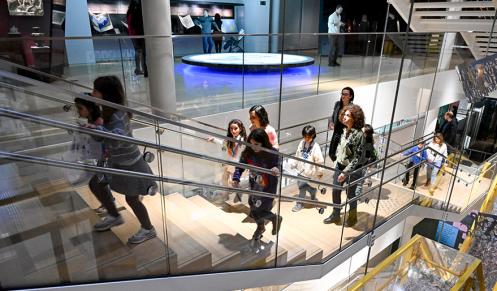
From museum trails to hands-on spaces and family events, arrange a fun day of discovery and connection for the whole family at the House of European History!
Suitable for visitors aged six and above accompanied by at least an adult, the museum invites you to learn more about European history together as a family, with intergenerational learning at the heart of our activities.
Get Started at the Family Kiosk
The first stop for families is the Family Kiosk, where our friendly staff will guide you through the available activities to ensure a seamless experience for everyone. Here you can have a chat, receive information about the family activities and the museum’s upcoming family events.
Before beginning your interactive journey through European history, play some games and become enchanted with the colourful walls of the Fables Room which are filled with restored paintings by Belgian painter Camille Barthélémy, depicting the “Fables” by Jean de la Fontaine.
Explore the Museum Together with Family Trails
Create lasting memories with our museum trails
which offer families diverse ways to explore the captivating collection.
These trails lead you through the galleries, providing an interactive and engaging experience for every member of the family.
Start by picking up ‘’The Daily Spy’’ –
a trail created in the style of a newspaper.
Then use your imagination to step into the shoes of a History Spy, find objects around the museum and follow the instructions outlined in the trail to crack the code and open a top-secret box. All this fun while learning more about European history!
‘’The Daily Spy’’ is available in English, French, Dutch and German
and is suitable for children age 6 to 12.
There are two levels of difficulty so that children in the same family or group can choose their level and play together in parallel. The trail takes approximately one hour to complete.
Hands-On Fun for All Ages with Discovery Spaces
Discovery Spaces are installations located across different floors throughout the museum. They focus on specific topics of the permanent exhibition, are available in 24 official languages of the European Union and are accessible during the opening hours of the museum.
Use the Discovery Spaces to investigate who took Princess Europa from her homeland, guess where spices come from using your sense of smell and enjoy an immersive video about the story of Europe. Let your mind wander and create a drawing to show us what you think future societies could look like.
Practical Information
ensuring that there is always an opportunity for small visitors and grown-ups to enjoy the museum together.
and exploring the museum as a family.
and equipped with baby-changing facilities.
Free lockers are available to store your belongings.





